Last year, we launched a first-of-its-kind contactless direct payments program in partnership with the Center for Effective Global Action (CEGA), and the Government of Togo. Leveraging machine learning in combination with satellite imagery and cell phone metadata, we were able to identify those living in extreme poverty and let them self-enroll in our mobile payment assistance program.

CEGA’s Anya Marchenko and GD’s Han Sheng Chia identified that their approach, termed MobileAid, can be a paradigm shift for delivering social protections:
Given that in-person validation provides valuable personal touchpoints, and MobileAid can be deployed quickly and at scale, countries could supplement one with the other. Emergencies or large scale shocks like famines and flooding may be the most natural use cases for the MobileAid approach to deliver significant early value.
During a crisis, time is of the essence, and policymakers may value the speed that the MobileAid model brings. As the machine learning algorithm screens a large swath of a population at high speed, producing a report of which individuals should be prioritized for aid, ground teams can enter afterward to enroll those missed and further community engagement. On the flip side, if machine learning algorithms over enroll beneficiaries by including those who are not eligible, ground teams could step in to narrow the pool of beneficiaries. In this example, the MobileAid approach is simply a “fast track”, or the first wave of targeting and enrollments, before other help can be mobilized.
Read the full post here.

Hello, this is quite exciting!
How do you expect this to change the marginal cost of delivering an additional cash transfer compared to the method GiveDirectly currently uses? Assuming GD spends $100 delivering every $1000 CT using its previous method, what would it look like with MobileAid?
Has GiveDirectly received any pushback about this new method? Such as if there's negative effects on those who self enroll and are excluded or general privacy concerns from users (regardless of their merit)?